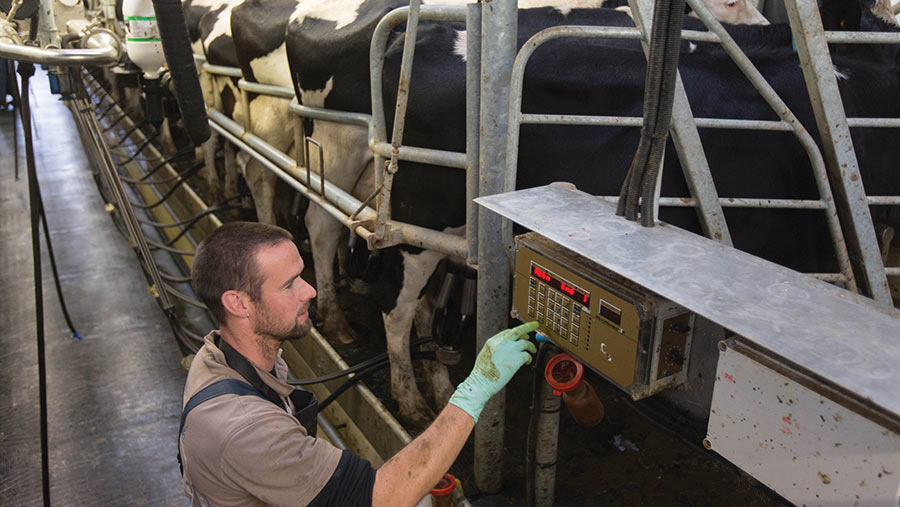How to record a case of mastitis
 © Tim Scrivener
© Tim Scrivener A two-stage mastitis recording system, run by a nominated person, is the key to satisfying farm assurance and medicine use requirements, and also provides a practical visual guide in the parlour.
There is detail on what to record for a mastitis case (see “What information to record for mastitis”), but other than a need for accuracy and consistency, no blueprint for logging it on farm.
The most effective recording system, according to AHDB senior knowledge exchange manager Jamie McCoy, is “whatever works for you”. This is because people take in information and describe it in different ways.
“It is the information that matters, and while a good software package is probably best, mastitis information needs to be available in the parlour to people who are milking, not in a computer in a farm office,” she says.
Nominated mastitis person
“Software is good for sorting data. But what is needed is a recording system that is logical [for the people using it] and where it is easy to find cases at a later date.
“If the recording system doesn’t come naturally to people, that’s when mistakes happen.”
Jamie suggests nominating a senior person in the business, such as the farm owner or a manager, to take responsibility for setting up and running a mastitis recording.
Having one responsible person transferring individual cow cases into a permanent farm database creates consistency. It also avoids important information having to be updated by the relief milker or a trainee worker.
For larger businesses, several nominated people will be needed for continuity to cover shifts, holidays and sickness.
Parlour records
Starting in the parlour, Jamie says a simple visual alert is needed for those who are milking.
This can be a colour-coded, tail tape system, based on whether a cow needs to be checked for clots, treated and recorded as a case, or milk has to be withheld from the tank, she says.
Alternatively, many parlours now use whiteboards on the wall to list cows, treatment dates and withdrawal periods.
However, she says the next stage of recording is when the person in charge of mastitis transfers these treated cases into a permanent, official record – before the information on a whiteboard rubs off, or tail tapes are removed.
This could be a diary, where mastitis cases are written in red pen or at the bottom of the page. It might mean a specific mastitis book, or where a software program comes into use, she says.
This long-term database of information is the one that can be analysed by a specialist in the event of a mastitis problem.
Analysis
A methodical approach to recording prevents treated cases from just becoming data, agrees The Dairy Group’s Ian Ohnstad, an AHDB mastitis plan deliverer.
“Records should create useful information that someone can interrogate to help make management decisions and prevent future mastitis cases,” he says.
“Data show milk-recorded herds have 30-33 cases a 100 cows a year, so in a 300-cow herd, that is 100 cases a year to record.
“People need to rationally work their way through the data, rather than be overwhelmed by the number of cows they are treating.
“But the more data you can record about a mastitis case, the more it can help – such as stage of lactation and date of calving – because mastitis is a multi-factorial disease.”

© Adobe Stock
Track progress
Ian thinks a third stage of recording would benefit large herds operating a team of milkers (where consistency is hard to achieve), as well as farms experiencing a big mastitis problem.
He suggests a second whiteboard in the dairy or parlour, where it would be seen on a regular basis, to track progress. This could use graphs and other visual aids to quickly communicate information.
Anyone who milks cows would then be fully aware of their involvement in how milking protocols affect mastitis incidence, he says. The board could also be the place to list cows with repeat cases over the course of a lactation.
“At a glance, you can see which specific cows are having multiple cases, instead of it being a generalised ‘she’s got mastitis again’,” Ian explains.
“There is no targeted culling policy on many farms, but this would help by highlighting cows that are developing into a problem [and thus considered for culling].”
What information to record for mastitis
- Cow identity
- Date treatment started
- Treatment dates and number of antibiotics tubes used
- Length of withdrawal period
Useful additional information
- Date the case was detected
- Quarter(s) affected
- Severity – mild (clots only), moderate (clots and swollen udder), or severe (sick cow)
- Treatment outcome – success/failure/lost quarter/cull/other
- Mild cases of clinical mastitis, and any other cases that were not treated with antibiotics, for whatever reason, must be recorded so that the true level of mastitis is known.
Source: AHDB Dairy
Red Tractor Farm Assurance requirements for recorded cases
- Record cases of clinical mastitis identified on the basis of relevant clinical signs including observable changes in milk and to the cow’s udder. May/may not be accompanied by general signs of illness (raised temperature, lack of appetite).
- Count cases at cow level, not udder quarter level. If a cow has two affected quarters, this should be counted as a single case.
- Use the seven-day rule to identify a new case in a previously affected cow. If mastitis clears up, then recurs in the same cow after seven or more days, this counts as a new case.
